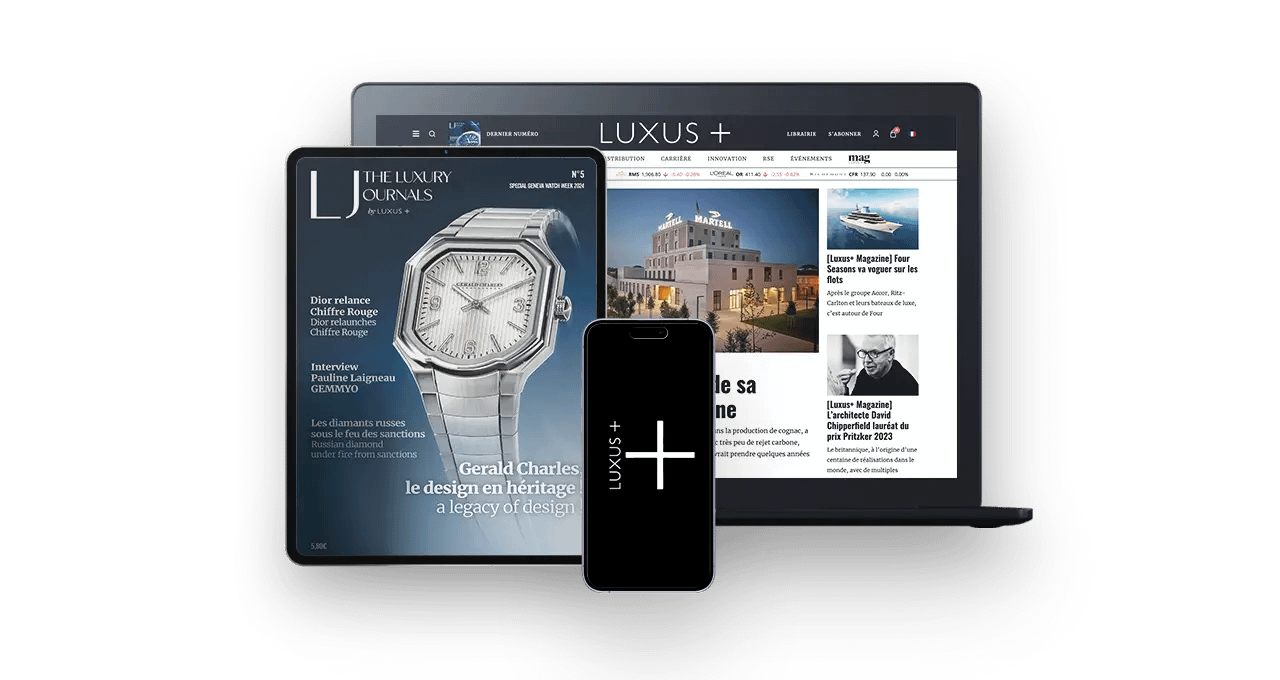The luxury goods industry can be a major customer for designs. How can this approach be relevant, and how has the law adapted protection regimes to meet the constraints of creativity? Here are some answers to help you build your strategy.
In France, design applications rose by 2.8% in 2023, after two consecutive years of decline, leading to fears that this protection might no longer meet the expectations of the creative sector. However, figures released by the Institut National de la Propriété Industrielle (INPI) at the beginning of the year point to an upturn, with 5,511 registrations (after 5,363 in 2022 and 5,853 in 2021) (1).
Some players in the luxury goods industry regularly turn to this form of protection. By way of illustration, a considerable number of designs have been registered in less than two years by Hermès (206), Cartier (106), Louis Vuitton (96) and Rolex (40), who have been particularly active (2). It may seem counter-intuitive to register designs for one’s creation, at the risk of revealing it to the public when it is not being marketed at the same time. However, it is possible to register a design with a deferment of publication, to preserve secrecy while complying with disclosure requirements (see below).
Alongside designs, copyright is a particularly strong form of protection under French law. These two tools can be used to protect a creation, and can be combined in accordance with the principle of the unity of art.
Sometimes misunderstood or confused, these two legal weapons inherent to creation, which can coexist, nevertheless differ in their regimes, each with its own advantages that need to be handled with care.
Criteria for application, duration of protection: distinct regimes for designs and copyright
A design or model requires registration with an office (in France, this is the INPI).
To be eligible for registration, the design must meet the following conditions:
- be new, i.e. no identical or quasi-identical design has been disclosed to the public prior to the date of protection granted by the filing (3), which presupposes that a prior art search has been carried out to ensure this;
- possess its own character, which is established when the overall visual impression it creates differs from that produced by any previously disclosed design.
The term of protection for a design is 5 years, renewable 4 times, for a total of 25 years.
The protection conferred by the registration of a design or model enables its owner toprohibit the exploitation of a product incorporating this design or model (4), it being specified thatarticle L. 513-5 of the French Intellectual Property Code (CPI) adds that “The protection conferred by the registration of a design extends to any design which does not produce a different overall visual impression on the informed observer ”, with certain exceptions mentioned by the CPI, such as acts carried out for private, experimental, illustrative or teaching purposes.
A registered design can be extended to territories other than that of the office in which it was registered.
At the time of filing, it is also possible to request deferment of publication to keep the filing secret and preserve the effect of surprise.
In France, the INPI offerstwo options: simplified filing, which allows publication of all or part of the reproductions within 30 months of filing; and the classic filing procedure with deferred publication, which postpones publication of all reproductions attached to the filing until a maximum of 3 years after filing. In both cases, publication will take place at the depositor’s request or on expiry of the above-mentioned deadlines (30 months in one case, 3 years in the other). No additional fees are charged by INPI, unlike the European Patent Office (EUIPO), which requires payment of royalties (40 euros for one reproduction, 20 euros from the 2nd to the 10th reproduction and 10 euros from the 11th reproduction onwards) for a filing with publication deferred until a maximum of 30 months after the filing date.
To avoid the pitfall of an irregular filing, the design or model must be faithfully and accurately reproduced (it may be a drawing or a photograph, but not both), the same model must be represented in an identical manner (neutral background, identical colors) and no external elements must appear in the filing (i.e. no explanatory notes, captions).
Registering a design has the advantage of not being very costly. In France, it costs 39 euros, to which must be added :
- 23 euros for a reproduction in black and white ;
- 47 euros for a color reproduction;
- 52 euros for 10-year protection at the registration stage.
However, designs are also subject to a specific regime that precludes registration : unregistered Community designs (UCDs). The conditions of novelty and uniqueness must again be met, and if this is the case, unregistered designs will be protected within the territory of the European Union for a period of 3 years from first disclosure. However, the holder of the design right may opt for protection by a registered design, with a grace period of twelve months from the date of disclosure to apply for registration of the design. If the application is not filed before the end of the grace period, only DMCNE protection can be claimed.
In this case, the owner will be able to prohibit exploitation in the course of trade only if the contested use is the result of an almost exact copy of his design, and if this copy is not “the result of a creative work carried out by a creator who could reasonably be expected to have been unaware of the design disclosed by the owner” (5). Recognition of protection here may be subject to certain judicial hazards: the obligation to provide proof of first disclosure to the public within the European Union, and the relatively short duration of protection (3 years instead of 25 years). Nonetheless, this protection can be useful for protecting products, such as those in the fashion industry, with a “short economic life cycle, for which it is advantageous to obtain protection without having to go through the formalities of registration, and for which the duration of protection plays a secondary role” (6).
Unlike designs, copyright in France requires no registration formalities, unlike copyright in the United States, and applies to all original creations, i.e. those that bear the imprint of the author’s personality in that they result from his or her creative choices. The original creation is then referred to as a work, and copyright can be assigned by its creator (a natural person) to a legal entity (for example, by means of a contract for the assignment of rights, an employment contract or a contribution to a company, subject to compliance with strict formalities).
The term of protection extends to 70 years from the death of the author. It confers on its holder economic rights (prohibition of exploitation, i.e. reproduction, representation, distribution or adaptation) as well as moral rights (7) (which are attached to the creator, are non-transferable but transmissible to his successors in title; the holder of the rights being able to represent the creator or his successors in title to defend the moral rights).
Exceptions to the copyright holder’s consent exist and are exhaustively provided for in article L. 122-5 of the CPI (private copies, analyses and short quotations, parody and the educational exception).
Unlike designs, for which the title issued contains a filing date, anyone claiming to own copyright in a work must be able toprovide proof of its creation date: In the field of haute couture, it is customary to usebailiff’s reports prior to the presentation of collections, enabling models to be given a certain date; the filing of an e-Soleau envelope with the INPI is also a means of obtaining such a date, for example by including photographs and descriptions of the creations in the envelope, it being specified that this envelope will be kept by the INPI for a maximum period of 10 years. Blockchain solutions are also commonly used.
The protection of a creation by design or copyright thusvaries in terms of the conditions that characterize them, and the duration of their protection. It is therefore necessary to assess the best strategy to adopt.
Cumulation with copyright, industrial property rights and burden of proof: in practice, the advantage of designs and models
In the luxury sector more than in any other, image is fundamental, since it is on this basis that a large part of reputation is acquired and endures over time.
Actions taken to protect creations and related rights must therefore be analyzed in the light of what will be most effective in ensuring the preservation of rights – by preventing the exploitation of an infringing product – as well as notoriety – for example, by avoiding an unfavorable court decision that would weaken the intellectual property protection policy in place and call into question the budget allocated.
A major difference between design and copyright lies in the burden of proof:
- in the first case, it is up to the defending party to demonstrate why the registered design should be cancelled (so that its effects cannot be enforced against it);
- in the second case, the party claiming copyright over a creation must demonstrate its originality.
French and European case law shows that it is not easy to demonstrate the originality of a creation. Judges regularly point out that the originality of a work may result from the choice of colors, designs, shapes, materials or ornaments, or from the original combination of common elements, but they do not always share the same analysis (see, for example, the decision of the Paris Court of Appeal, March 23, 2021, no. 18/28435, which considers that the originality of a bracelet has been demonstrated in this case, whereas the Paris Court of First Instance had previously rejected it). Proof of originality will also be required to obtain judicial measures that may be ordered to prevent or halt copyright infringement, prior to any summons of an infringer before a court.
As copyright does not confer any “title”, and can be claimed up to 70 years after the death of its author, it is advisable to register a design to reinforce the protection of one’s creations when the application criteria are met. Admittedly, the term of protection cannot extend beyond 25 years, but the effects attached to it (title, date, burden of proof resting on the defendant) and the cumulation with copyright represent significant advantages in favor of design protection.
Recently, the Paris Court of First Instance even went so far as to make its analysis conditional on the creative object in question – which is more than questionable – stating, in a case where the plaintiff based its claims on both unregistered design protection and copyright, that “As the first of these protection regimes [unregistered designs] is specially adapted to products such as the garments in question, it should be examined first. The second [copyright] should then be examined only if and insofar as it is likely to justify claims that the first would not have been sufficient to substantiate. ” (TJ Paris, January 26 2024, no. 22/10372).
Moreover, the owner of the rights to a creation may choose to use only one of these assets, which would not be the case in the absence of an industrial property title (design or model, or trademark).
Consequently, it is essential to define a protection strategy for any creation, both before and after it is used, and to be supported in this approach in view of the financial and image impact.
Footnotes
- See INPI press release dated February 9, 2024.
- Designs registered between January 1, 2023 and September 11, 2024 in accordance with INPI’s public databases.
- On this point, the legislator has taken care to specify that “ the design or model is not deemed to have been disclosed to the public simply because it has been disclosed to a third party under an explicit or implicit condition of secrecy ” (article L. 511-6 al. 2 of the CPI) and that disclosure during the 12 months prior to filing is not taken into account “ if the design or model has been disclosed by the creator or his successor in title, or by a third party on the basis of information provided or acts performed by the creator or his successor in title ” or “ if the design or model has been disclosed as a result of abusive behavior against the creator or his successor in title ” . (article L. 511-6, al. 3 a) and b) of the CPI ).
- Article L. 513-4 of the French Intellectual Property Code stipulates that “ In the absence of the consent of the owner of the design or model, the manufacture, offer, placing on the market, import, export, transshipment, use or possession for these purposes of a product incorporating the design or model is prohibited ” .
- Article 19.2 of Council Regulation (EC) n°6/2002 of December 12, 2001 on Community designs.
- Council Regulation (EC) n°6/2002 of December 12, 2001 on Community designs, cons. 16).
- For example, the right to authorship (the author must be credited), the right to integrity and respect for the work.
Read also > [CHRONICLE] Chanel N°5 and trademark law: a “High Five” refused to Chanel by the EUIPO Opposition Division
Featured Photo: Peter Saville for Burberry, 2020 © Burberry






































